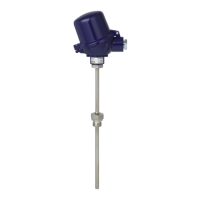3345267.08 06/2011 GB/D
30 WIKA operating instructions RTD and TC, intrinsically safe designs
GB
The welded parts, process connections, compression ttings, thermowells or housings used
must be designed such that they withstand all inuencing variables resulting from the process,
such as temperature, ow forces, pressure, corrosion, vibration and impacts.
7.4.3 Partition wall for use in Zone 0 or Zone 1/2 or separation between hazardous area
and non-hazardous area
If the wall thickness is less than 1 mm, the instrument must also be marked with an "X" or a safety
instruction in accordance with 29.2 of EN/IEC 60079-0, with the special proviso that for safe use
it must not be subjected to ambient stresses that may have an adverse eect on the partition
wall. If the partition wall is continuously subjected to vibrations (e.g. vibrating membranes), its
fatigue limit at the maximum amplitude must be stated in the documentation (see Section 4.2.5.2,
EN/IEC 60079-26).
Alternatively, a thermowell of suitable minimum wall thickness may be used by the customer.
When using a thermowell/neck tube, the overall instrument must be constructed such that
it allows installation in a way that results in a suciently tight gap (IP 67) or a ame path
(EN/IEC 60079-1) towards the less hazardous area.
8. Electrical connection values
8.1 Electrical data without built-in transmitter or digital display
For Group II instruments (potentially explosive gas atmospheres)
*3,
the following maximum
connection values apply:
U
i
= DC 30 V
I
i
= 550 mA
P
i
(at the sensor
*1
) = 1.5 W
For Group II instruments (potentially explosive dust atmospheres), the following maximum
connection values apply:
U
i
= DC 30 V
I
i
= 550 mA
P
i
(at the sensor
*2
) = For the values, see "Table 2" (column 2) on page 24
*1 The permissible power to the sensor depends on the temperature of the medium TM, the temperature class
and the thermal resistance Rth, but shall not be more than 1.5 W.
For calculation examples, see chapter "9. Calculation examples for self-heating at the sensor/thermowell tip".
*2 The permissible power to the sensor depends on the temperature of the medium TM, the maximum allowed
surface temperature and the thermal resistance Rth, but shall not be more than the values from "Table 2"
(Column 2), see above.
*3 Use in methane atmospheres
Owing to the higher minimum ignition energy of methane, the instruments can also be used where methane
causes a potentially explosive atmosphere. The instrument can be optionally marked with IIC + CH4.
7. Information on mounting and ... / 8. Electrical connection values

